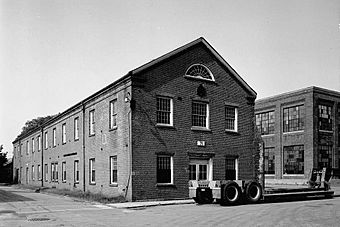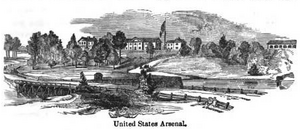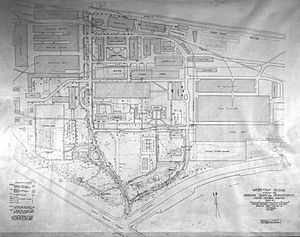Watertown Arsenal facts for kids
Quick facts for kids |
|
|
Watertown Arsenal Historic District
|
|

Building #71
|
|
| Location | Watertown, Massachusetts |
|---|---|
| Built | 1816 |
| NRHP reference No. | 99000498 |
| Added to NRHP | May 14, 1999 |
The Watertown Arsenal was a very important place in Watertown, Massachusetts. It was a big military base located right by the Charles River. Today, this historic spot is recognized by engineers and is listed on the U.S. National Register of Historic Places. You can now find a park, restaurants, offices, and the main office for a company called athenahealth there.
Contents
A Look Back: The Watertown Arsenal's Story
Early Days: Building an Arsenal
The Watertown Arsenal started in 1816. The United States Army built it on about 40 acres of land. Its main job was to receive, store, and give out weapons and supplies. It took over this role from an older base, the Charlestown Arsenal.
The first plan for the arsenal included 12 buildings. They were lined up facing the river. Alexander Parris, who later designed the famous Quincy Market, was the architect. The buildings were made of brick with slate roofs. They were built in the Federal style, which was popular back then. A tall wall surrounded the whole area. By 1819, all the buildings were finished and ready to use.
Growing During the Civil War
The arsenal slowly grew bigger over the years. This growth really sped up during the American Civil War. The arsenal expanded a lot to make gun carriages for field and coastal guns. During the war, a large machine shop and a smith shop were quickly built. These new buildings looked like modern factories. Many smaller buildings were also added.
The Big House: Commander Rodman's Quarters
During the Civil War, a new house was built for the commander. Captain Thomas J. Rodman ordered it. He was famous for inventing the Rodman gun. This huge house was about 12,700 square feet! It became one of the biggest commander's houses on any U.S. military base.
Today, this mansion is also listed on the National Register of Historic Places. The house was very expensive to build. Because of the high cost, Captain Rodman was moved to lead another arsenal. He went to the Rock Island Arsenal in Illinois, where he built an even bigger house!
From Storage to Manufacturing
The Watertown Arsenal kept growing until the early 1890s. In 1892, things changed a lot. Congress decided the arsenal should focus on making gun carriages. This meant it became a factory complex instead of just a storage place. Many new, large buildings were constructed. These buildings looked more like typical industrial factories. In 1897, the arsenal bought another 44 acres of land. A hospital was also built there.
Working Smarter?
Between 1908 and 1915, a new way of working was tried. It was called "scientific management." The Army thought it saved money. However, the workers really disliked it. Eventually, Congress stopped its use because of the workers' complaints.
World Wars and Beyond
During World War I, the arsenal almost tripled in size. Building #311 was one of the biggest steel-frame buildings in the United States. It was designed to hold very large gun carriages and the machines to build them. Railroad tracks ran all over the arsenal.
World War II brought even more expansion. The arsenal added 7 more acres with existing factory buildings. It produced steel artillery pieces during this time. From 1959 to 1970, a special research reactor, the Horace Hardy Lester Reactor, was on site. It was used for material research programs.
Civilian Life for the Arsenal
In 1968, the Army stopped its main operations at the arsenal. About 45 acres were sold to the town of Watertown. The remaining 48 acres became a research center for the Army. It was first called the United States Army Materials and Mechanics Research Center (AMMRC). Later, in 1985, it was renamed the United States Army Materials Technology Laboratory (MTL).
In 1995, all Army activity ended. The rest of the site was then changed for civilian use. The arsenal site was once on a list of highly polluted places called Superfund. But after a lot of cleanup, it was removed from that list in 2006.
Images for kids






